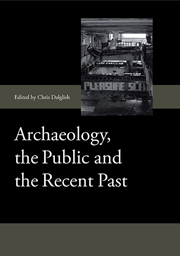Book contents
- Frontmatter
- Contents
- List of Figures and Tables
- List of Contributors
- Archaeologists, Power and the Recent Past
- Part One Constructing Memories, Constructing Communities
- Open-Air Museums, Authenticity and the shaping of Cultural Identity: An Example from the Isle of Man
- Loyal yet Independent: Archaeological Perspectives on Remembering and Forgetting World War I on the Isle of Man
- Public Engagement at Prestongrange: Reflections on a Community Project
- Archaeology for All: Managing Expectations and Learning from the Past for the Future – the Dig Manchester Community Archaeology Experience
- Rediscovering, Preserving and Making Memories at Community Archaeology
- Part Two Engaging the Past, Engaging the Present
- Index
Public Engagement at Prestongrange: Reflections on a Community Project
from Part One - Constructing Memories, Constructing Communities
Published online by Cambridge University Press: 05 September 2013
- Frontmatter
- Contents
- List of Figures and Tables
- List of Contributors
- Archaeologists, Power and the Recent Past
- Part One Constructing Memories, Constructing Communities
- Open-Air Museums, Authenticity and the shaping of Cultural Identity: An Example from the Isle of Man
- Loyal yet Independent: Archaeological Perspectives on Remembering and Forgetting World War I on the Isle of Man
- Public Engagement at Prestongrange: Reflections on a Community Project
- Archaeology for All: Managing Expectations and Learning from the Past for the Future – the Dig Manchester Community Archaeology Experience
- Rediscovering, Preserving and Making Memories at Community Archaeology
- Part Two Engaging the Past, Engaging the Present
- Index
Summary
The aims of the Prestongrange Community Archaeology Project (2004—10) were two-fold: a) to explore what might survive of the pre-colliery landscape at Prestongrange (Prestonpans, East Lothian, Scotland); and b) to provide an opportunity for interested individuals to get involved with a local archaeology project. Although the archaeological discoveries and the outcomes of historical research have been fascinating and provide a wealth of new information, the engagement of the volunteers with the project has been of particular interest. Te project started off as a predominantly top-down initiative with the fieldwork and training being undertaken by CFA Archaeology Ltd and the overall project overseen by the East Lothian Council Archaeology Service. However, a number of key elements defined the way in which the professionals engaged with the volunteers. A degree of fluidity in the way the project was organised allowed certain aspects ofthe project to grow organically, and for the volunteers to take on responsibility for research objectives. The project has been educational for all involved through the human dynamic and the interaction and relationships between team members.
BACKGROUND AND INTRODUCTION
Prestongrange is an open air colliery museum managed by East Lothian Council and located between Musselburgh and Prestonpans (Fig. 3.1) in East Lothian, Scotland. It has a lengthy and highly significant social and economic past. Standing remains of the 19th-century colliery and 20th-century brickworks dominate the site but it also had a historically-attested earlier life associated with the pottery and glass-making industries, which had taken place here adjacent to a thriving harbour.
- Type
- Chapter
- Information
- Archaeology, the Public and the Recent Past , pp. 55 - 64Publisher: Boydell & BrewerPrint publication year: 2013



